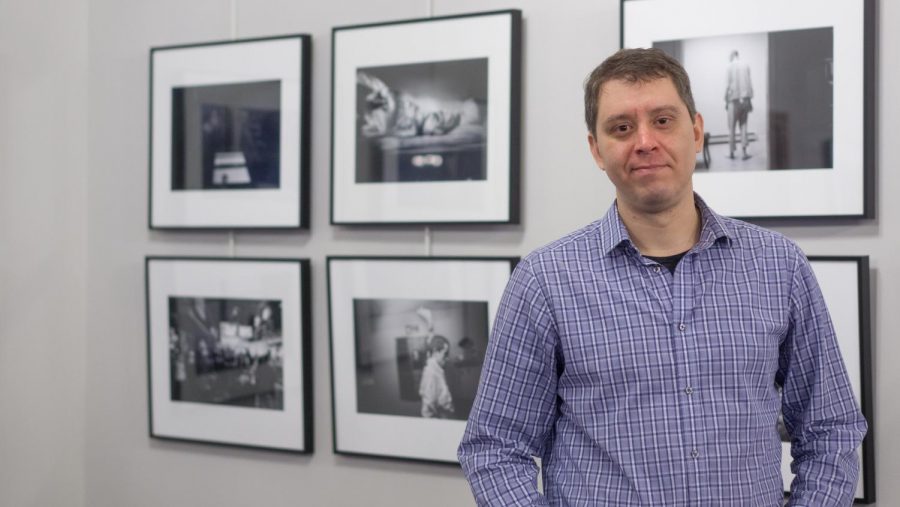Photojournalist Christopher Capozziello discusses inclusion, representation in photography
Christopher Capozziello in front of his 35mm film photos at the University YMCA on Monday. Capozziello is a visiting scholar to the University teaching a photojournalism course about inclusivity and representation in photography. “We photograph everything and look at nothing. The way that we interact with photographs is very important,” Capozziello said.
February 19, 2019
Award-winning photojournalist Christopher Capozziello is teaching an eight-week course and presenting his work in a series of events through the George A. Miller Visiting Professors and Scholars Program at the University.
Capozziello’s visit invites students and faculty to experience his work through a series of events. A documentary film of Capozziello’s project, “The Distance Between Us,” will be screened Tuesday at 7 p.m.
Photos from “The Distance Between Us” will be featured at the University YMCA Murphy Gallery in Champaign.
A Center for Advanced Study and MillerComm lecture will be held at the Spurlock Auditorium, entitled “Photojournalism as Visual Ethnography,” on Wednesday at 4 p.m.
Capozziello will also be giving a lecture on the opening night of the exhibit on Thursday at 5 p.m.
Get The Daily Illini in your inbox!
Throughout the first half of this spring semester, Capozziello is teaching a JOUR 460 section called “Photojournalism in Society,” a course looking into journalism as a method of inclusion and representation.
“The hope is that we look more deeply and we don’t make assumptions,” Capozziello said.
The silent element of photographs is what Capozziello identifies as a reason they are dangerous. He says their silence makes them liable to exacerbate assumptions.
“There’s a danger in pictures because they’re silent. And you will come to a photograph and it will mean something different to you because you have certain life experiences that are very different than mine. But your life experiences aren’t all-encompassing,” Capozziello said. “They’re very narrow to your experience.”
Capozziello said more questions than answers need to arise from looking at photographs.
“Often times we look very quickly and we move on and we don’t spend time with the pictures. We say these cliche things like a picture is worth a thousand words,” Capozziello said. “Well, if it’s actually worth that, it should be worth our time because to read a thousand words is more than a passing glance.”
Curiosity surrounding people and their backgrounds led Capozziello to photograph stories of a woman with breast cancer, a childhood friend addicted to drugs and an active Ku Klux Klan member.
With the development of photographic technology, Capozziello said the reasons for and methods of photography have changed. The ubiquity of pictures has never been so extreme as it is today. Parents would photograph birthday parties, graduations or other big life events that were happening, Capoziello said.
“We photograph everything and look at nothing,” Capozziello said. “The way that we interact with photographs is very important.”
The story of Capozziello’s twin brother, Nick, living with cerebral palsy is portrayed in the photography book, “The Distance Between Us”. The collection of photographs led Charles “Stretch” Ledford, associate professor in Media, to reach out to the University and invite Capozziello to the program.
Ledford said he purchased Capozziello’s book in 2013 and felt the photojournalist’s work would resonate here on campus.
“We try to bring the very best people in the world here,” Ledford said.
Capozziello and a number of selected Division of Disability Resources and Educational Services students discussed the need for conversations of disability to be expanded from the individual to be shared in everyday life in a familial level wrote Susan Sears, director of Beckwith Residential Support Service and DRES, in an email.
“Everyday experiences of family life (present their) own unique challenges between parents and children for us all. Christopher’s work conveys a glimpse into the joy, struggle and complexities that we as people have through our relationships with our family members,” Sears said.







